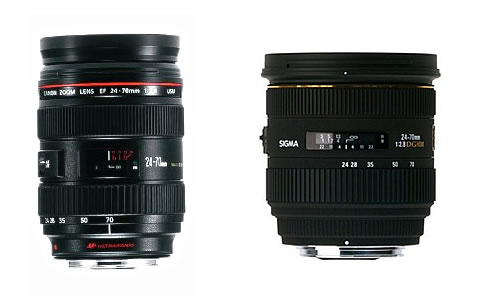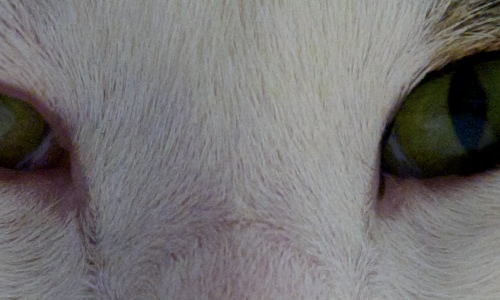
UPDATE Jan 2012: I reviewed a different copy of the Sigma 24-70mm over here, and liked it much more. For balance, you should probably read that review too.
I’m a big fan of prime lenses, and my ideal set up might be something like 2 Canon EOS 5D Mark IIs each paired with one of the following: 35mm f/1.4L, 50mm f/1.2 L, 85mm f/1.2 L or 135mm f/2 L, depending on circumstances. Shooting with 2 cameras would give me wider and close-up options without changing lenses while keeping the speed and quality I like about primes. But since that’s a $10,000 ideal world I’ve just described, I’ve also been looking for a replacement for my Canon 24-105mm f/4L lens that would allow me some flexibility in framing while doing portrait sessions.
The 24-105mm f/4L is a great walk around lens, but I don’t make any money walking around, and it’s not a very good portrait lens. I live in the area between f/1.4 and f/3.2 – partly to freeze movement during indoor shoots, but mainly for the bokeh (the background blur).
All the image stabilisation in the world won’t help when a three year-old is running at you along a dark corridor, especially if you want to blur out the distracting pictures on the wall behind him. So the 24-105mm is off to eBay (drop me a line if you might be interested in buying it).
I’ve had the Canon EF 24-70mm f/2.8L USM on loan from borrowlenses.com for a 3-week test, and I also got my hands on the Sigma 24-70mm f/2.8 IF EX DG HSM
for a comparison.
A few points before we start on the details. I was doing a subjective comparison, not a scientific one. I didn’t go looking for pincushion or barrel distortion, or measuring center and edge sharpness at different apertures and focal lengths. So don’t shout at me because there are no MTF charts.
Instead I shot real life things in the real life way I actually would.
The Canon 24-70mm f/2.8 – the heavy good news
First up, it’s huge. Heavy and unwieldy with a lens hood that looks like a bucket (and which you can’t turn round and then put the camera down anywhere). For some people this won’t be a problem, because they’ve got stronger hands and wrists than me, or they never ever shoot one-handed, or they want to bang in nails with their equipment.
But for me it’s an issue because I don’t want my gear to look super intimidating to children, I do shoot one-handed sometimes (with the camera away from my face so I can keep the interaction with the kid), and because my arm ached when I used it a lot.
But it’s also really good – definitely sharp enough for me at f.2.8, contrasty and with lovely colors. Auto-focus seemed acceptable even on my ageing 5D which is not very speedy.
The laws of physics mean that you get much more background blur at the 70mm end than the 24mm end (for the same aperture and distance from subject), so bear that in mind when setting up your shot.
The Sigma 24-70mm f/2.8 – the lighter bad news
I really wanted to like the Sigma 24-70 f/2.8 for a number of reasons. One of them was the price – at $900 it’s $400 or so less than the Canon. Another was the size and weight – it’s by no means svelte, but it’s decidedly lighter and shorter than the Canon – aka’ the brick’. It definitely makes for a more comfortable shooting experience, and it’s a bit less daunting to be on the other end of (although the 82mm filter diameter is as large as I’ve seen, and means filters are expensive).
I’d heard good things about it, and I also liked the idea of not automatically going for the red-lined L lens without looking around at other options.
Which is all fine, but sadly the copy I got front-focused horribly. I’d read that this problem had afflicted some people, and it shows how much I’d come to depend on Canon reliabilty that I didn’t really think it would happen to me. I’ve probably shot with nearly a dozen different lenses (including one Sigma, the estimable 10-20mm for crop sensor bodies) and not had a single problem.
But it was when I was taking photos of Christmas tree decorations I saw how dispiriting a problem this is. You focus, you shoot and then the images look nothing like what you thought you got. Here’s an example grab from Aperture (which has a fancy overlay showing where the focus was) – the focus point is market with the bold square. As you can see, where the camera actually focused was in front of that.

It seemed to do better when the subject was further away from the camera, and some of the shots it produced were very very sharp (see the individual hairs on our cat’s ridiculous white and pink nose below), but if you can’t trust the lens to focus where you want it too (especially when you’re using a deliberately narrow depth of field), then it’s not any good to you.

I’d read that sending the lens to Sigma to calibration often helped, and I actually called them to see about sending it in. But the uninterested guy on the phone told me I should send my camera too, and that because of where I lived, it was actually going to a repair shop in Arizona, not to Sigma USA itself. They also wanted me to tell them by how many inches I wanted it adjusted.
I had a few problems with this scenario. The first is that if I spend $900 on a lens, I’d like it to work out of the box. The second is that I’m not sending my main camera body anywhere if I can help it, and the third is I think it’s a reasonable expectation that I can use any of my lenses on any of the bodies I might have now and in the future – I don’t want it tied to one body. A further point is that asking me by how many inches I want it adjusted is a completely ridiculous question – it was clear that the distance the lens front-focused (or was accurate) depended on how far away the subject was from me. A single adjustment might cause more harm than good.
All this shook my confidence in Sigma’s ability to make a good lens in the first place, and in their ability to fix a defective lens. If calibrating is required, shouldn’t the QC in the factory have spotted this in the first place? So I returned it to Amazon for a refund (great returns policy, by the way).
The upshot
So the copy of the Canon 24-70mm I got was definitely way better than the copy of the Sigma 24-70mm I got. Would Sigma have been able to fix the lens? Quite possibly, but I’ll never know, because I didn’t chance it. And I know other people have nothing but good things to say about their copy, so I can’t dismiss the whole idea of it.
But I still don’t completely love the Canon, partly because of its substantial bulk. There are rumours of a new version of the 24-70mm being in the works (possibly to be announced at or before the WPPI convention next month), so the prudent thing right now seems to be to wait and see.
Part of my underlying problem is the feeling of compromise I always get with shooting with a zoom. Sure it’s convenient, but that’s all it’s got going for it.
The Canon EF 50mm f1.4 and Canon EF 85mm f/1.8
are my bread and butter lenses – almost all the shots I take for clients are with these, and even though they’re not L-class, I seldom feel like I’m short-changing myself or the image with them.
I’d thought that the flexibility of the zoom would be liberating, but instead it feels like I’m getting pretty good versions of shots that I couldn’t get with the primes, but no fantastic images. Maybe I’d rather miss some OK shots to get more great shots.
If you’re a newspaper shooter (any of those left?) or you shoot weddings, then getting a pretty good version of a shot is often all you can do, given the rapidly changing circumstances. It’s a little like that shooting kids’ portraits, but things are often a bit more under your control. So you’ve got the chance to get the great shot that the prime will give you.
Which of course, brings me back to the ideal world setup with matching 5D IIs and a quiver of L prime lenses. Where’s that lottery ticket, again?
4 replies on “Big and Bad: Canon 24-70mm f/2.8 L vs Sigma 24-70mm f/2.8 IF EX DG HSM lens review”
[…] I noted recently, my ideal portrait shoot set up with probably be something like 2 5d Mk IIs sporting L-series […]
[…] Sigma guys were friendly but didn’t make me change my opinion of their reliability after my recent bad experience with their 24-70 f/2.8. I told them about it and they shrugged – “Sometimes it’s […]
[…] readers (hi, Mum), will perhaps recall that around this time last year, I tried out a Sigma 24-70mm f/2.8 IF EX DG HSM AF as a replacement for my able but unloved Canon […]
I have the Tamron 28-75mm 2.8.
It is very sharp, light and the price is right.